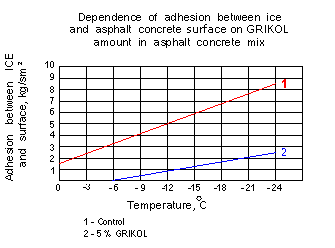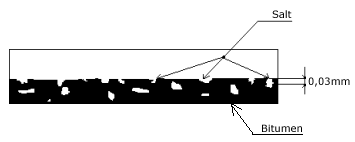Information
Grikol is a new de-icing
product which is developed by the Russian research and
production–institute NPO Rosdornii in Moscow. Grikol is a filler to the asphalt-concrete and
consist of
80% Sodium chloride (NaCl), 10% Calcium Chloride (CaCl2) and 10% Siakor.
The unique part of Grikol
is the component Siakor
which is a silicon–organic, non-toxic,
non-flammable -compound in powder format with a freezing-point
of -50
degrees Celsius. Siakor
is an inhibitor against corrosion and can also be used as a water
rejecting,
“anti-corrosion” substance. Siakor
adds extra de–icing effect to the chlorides and
reduces the corrosion
damage by binding the redundant chlorides from Grikol
and form an insoluble
compound of these.
Grikol is developed to prevent
ice from forming on the road surface and is used as a filler when the
asphalt-concrete is mixed. Grikol is used in the upper layer of
the pavement according to
traditional technology.
Grikol has a solid anti–icing effect
in temperatures between 0 to -6 degrees Celsius and therefore prevents
ice
formations on the road when the temperature starts to fall. In lower
temperatures (below -6) Grikol prevents ice and snow from freezing and
to get
stuck on the road surface, this makes the maintenance job much easier
and less
expensive.
Grikol:
- Makes
the road safer.
- Reduces
the road maintenance.
- Reduces the maintenance cost wintertime.
- Reduces
the traffic cost.
- Has a 2-3 times less corrosion effect on metal.
- Has a constant de–icing effect as long as the
pavement lasts.
- Is
environmentally friendly.
- Does not generate any toxic gases.
- Is not explosive or flammable.
- Does not cause any damage to the
asphalt-concrete.
According to NPO Rosdornii Grikol will compensate for
all its initial costs even during its first year in use
because of the
reduced road maintenance, safer roads (less traffic accidents), less
corrosion
on vehicles and a cleaner environment.

Theoretical determination of salt emission –
Grikol
pavements
The following relations are used:
(number of vehicles) × (frequency of vehicles with studded tires) × (grams of eroded pavement per
km, vehicles with studded tires) × (percentage of Grikol in
pavement)
Background
information:
- According to Mats Hansson at ”Stockholm
Entreprenad” the frequency of vehicles with studded tires in Stockholm
during the winter season (nov – apr (=180 days and nights)) are about 35% of the vehicles. This is the average number from calculations
done during the winter seasons 1985-86 to 1992-93.
- According to Torbjörn Jacobson at ”VTI” (the Swedish National Road and Transport Research
Institute) there are various of studies done and the
average vehicles with studded tires erodes 7 gram per km pavement. An
average road lane is about 3,5m wide. Because light metal–studs erodes less
pavement than steel–studs does and the frequency of light metal-studs
have increased during recent years, we now count the erosion to be
about 5 gram per km pavement for vehicles with studded tires.
- The percentage of Grikol most often used in the
pavements made in Sweden were about 3%. According to recommendation
from Grikol Ltd. in Moscow, the percentage of Grikol should be 3 to 5%.
The amount of salt in Grikol is 90% (80% NaCl, 10% CaCl2 and 10%
Siakor) therefore the total amount of Grikol-salt in a Grikol pavement is about 2,7%.
According to Kent Gustafsson
at ”VTI” the approximate erosion of a vehicles with normal tires is about 1% compared to a
vehicles with studded tires.
Calculation of salt-emission
per 1000 YDT (yearly average daily traffic), square meters of lane and
year: 2,43 × (1000 × 185 × 1,0 × 0,05 × 0,027) / (1000 × 3,5) = 2,50 gram
Calculation of salt-emission
per 1000 YDT, square meters of lane and winter season: 1000 × 180 × 0,35 × 5 × 0,027 / (1000 × 3,5) = 2,43 gram (erosion from un-studded tires
are negligible)
Calculation of salt-emission per 1000 YDT, kilometers of lane and winter season: 1000 × 180 × 0,35 × 5 × 0,027 = 8505 gram (erosion from un-studded tires are negligible)
g
Reflections on calculations of salt-emission
There are some uncertain
parameters in the calculations above, for example the erosion. However,
these
calculations gives us a clear indication of the magnitude of
the salt-emission.
It also becomes clear that the salt-emission is
in direct proportion to the amount of vehicles, the frequency
of vehicles
with studded tires and the amount of Grikol used in the pavement.
The result of these
calculations shall be compared to the amount of regular road salt
generally
used during the past years. According to information from Lennart Karlström
at ”Stockholm Entreprenad” the amount of salt used in Stockholm during
the winter season of 93-94 was
in average 507 gram per square meter.
If you count with an average of 10.000 YDT in Stockholm, you will get
(according to the calculations above) 25 gram of salt per square
meter and year when using Grikol pavements.
That is only one-twentieth of the usual slat-emission. Usually we claim that using
Grikol will decrease the salt-emission to one-tenth of the usual. This
calculation
includes some complementary salting.
Another question that arises
is how far this relatively low amount of salt
which erodes from the Grikol
pavement will last in a matter of de-icing the road?
I believe that only active service measurements with a
“friction-car” can give us reliable
information in this
matter. However, to get a rough estimation we have calculated on some
reasonable and theoretical arguments below.
g
De-icing ability of a Grikol pavement - Theoretical calculations
Background information:
- It is reasonable to assume that half of the
salt substance is continuously exposed on the surface of the Grikol
pavement (schematic picture below).
- According to Grikol Ltd. the Grikol-salt has an
average size of 0,060mm in diameter.
- The total amount of Grikol is 3% of the weight (the Siakor-part of Grikol does also have
anti-icing properties, that is why we count 3% and not 2,7%).
- The density of the final pavement-substance is
about 2.350kg/m³
Calculated amount of Grikol
which is exposed on the road surface but still bound to the
Bitumen:
0,03 × 0,001 × 2.350 × 0,03 = 2,1g/m²

Reflections on theoretical calculations of
de–icing
ability
In the calculations above we assume that the exposed salt does not leach. This may be probable to some extent because the erosion makes the pavement constantly expose new salt particles and because of the Siakor in Grikol, which besides the freezing point-lowering properties, also has a moisture-resistant feature that counteracts the leaching.
The result of 2,1g/m² shall be compared to the
information provided by Lennart Axelsson at VV (the highway
department), that it takes 5-10g/m² when the road surface holds a water volume of
0,1mm (this gives a salt solution of
5-10%) to give the pavement a sufficient
de-icing capacity. Other factors that affect the de-icing and
friction:
- the erosion is not equally spread over the 3,5m
wide road surface, instead it is concentrated to the primary wheel
tracks on the road.
- a large part of the eroded and exposed Grikol
salt contributes to the de-icing of the road.
- because that the Grikol salt is bound to the
road surface, snow and ice will melt from underneath and will not
freeze to the pavements as before and the friction from the car wheels
can more easily remove the ice from the road surface.